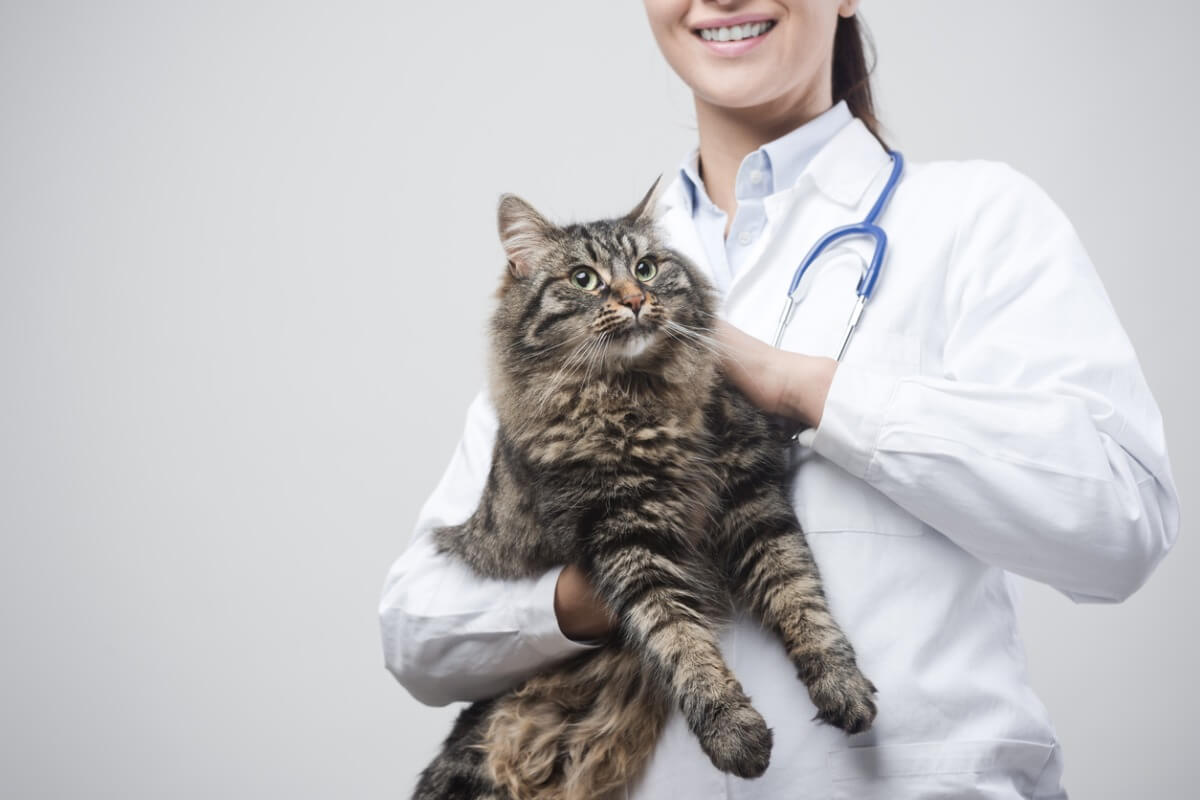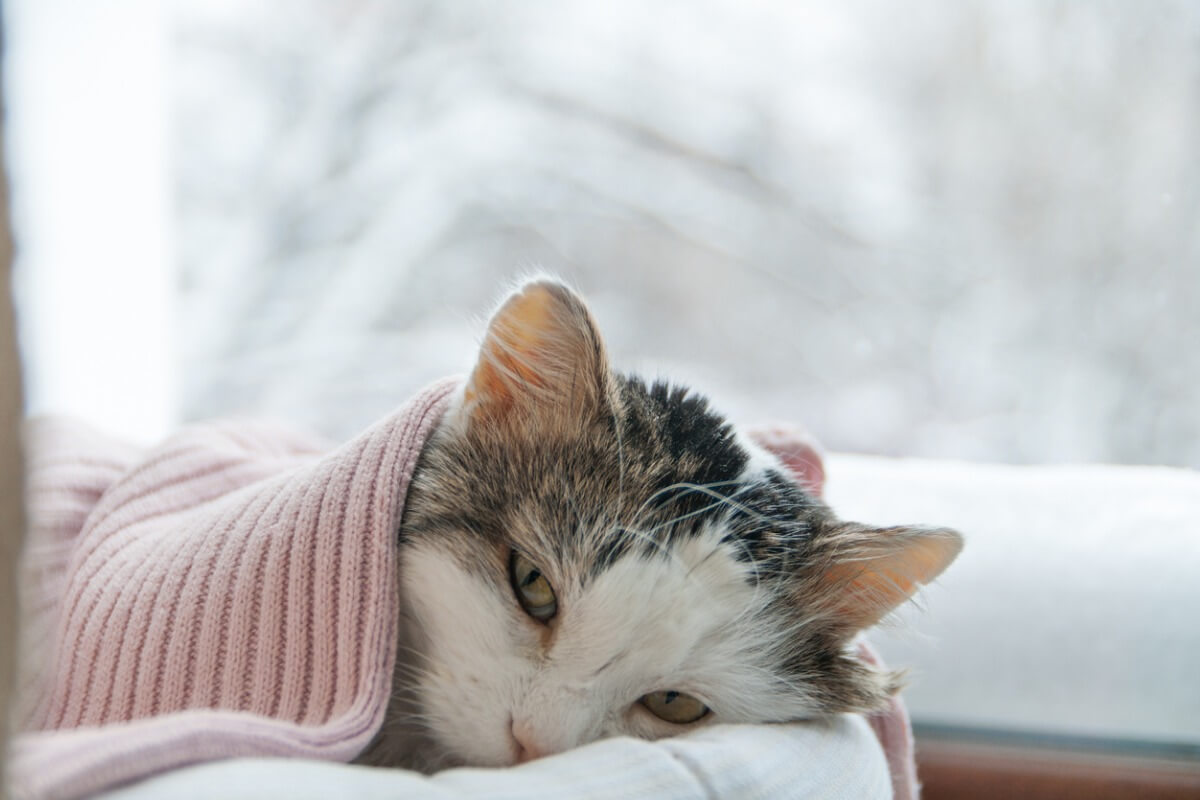Abscesses in Cats: Causes, Symptoms and Treatment

Animal skin is truly amazing. Experts consider it to be the largest organ of the body, and it’s responsible for several different functions that protect the animal’s health. However, it isn’t exempt from manifesting different illnesses and diseases. One of the most common problems are abscesses in cats.
If you have a cat at home, we encourage you to read on! In the following lines, we’ll share with you the basics of this frequent situation, its characteristics, and the correct way to address it to avoid secondary complications. Let’s get going!
What are abscesses in cats?
An abscess occurs when a considerable amount of purulent material accumulates inside a cavity. Abscesses in cats represent the most common bacterial infection in this species. The usual area where this occurs is the skin, but any organ can be affected by this condition.
At first glance, abscesses in cats are seen as reddened and inflamed areas. In some cases, where the skin has suffered a more serious injury, the wound will show signs of ulceration. Regardless of where on your pet’s body you notice an abnormality, it’s important to visit your veterinarian for a checkup.
Causes of cat abscesses
One of the main functions of the skin is to act as a barrier of defense against foreign agents that inhabit the environment. When the skin is injured, either by a bite or scratch from another cat, it opens the door for opportunistic bacteria to colonize it and begin a series of adverse effects that can lead to the formation of an abscess.
In addition to reaching wounds, germs have the ability to invade the interior of the feline’s body by other routes. Their goal is to reach distant areas inside the animal where it’s feasible for them to produce abscesses in cats. Here are the most important ones:
- Bloodstream: Once the bacteria have reached the circulation, the resulting sepsis will generally affect your pet’s entire body. At this point, cat abscesses can emerge in any internal organ (the liver, kidneys, and the pancreas are just a few examples).
- Airways: Sometimes, cats can accidentally inhale non-sterile foreign particles and germs that make their way into the lungs and trigger the growth of abscesses.
- Dental processes: It’s a well-known fact that a cat’s mouth is full of bacteria that are harmless in this area, but are dangerous for other regions. When small wounds originate in the mouth that allow access to these germs, it will facilitate the emergence of abscesses.

Symptoms of abscesses in cats
The symptomatology caused by abscesses in cats isn’t always the same and it all depends on the affected area, its size, and the bacteria involved. Your feline could be restless, aggressive, or behave strangely because of the discomfort the abscesses are causing.
The pus can appear in different ways: liquid, crumbly or waxy. The pressure exerted by this accumulation will give rise to the following signs:
- Inflammation (mostly noticeable in skin abscesses).
- Erythema (reddening of the skin).
- Increase in temperature of the affected area.
In some cases, the abscesses burst and the condition becomes more complicated due to the appearance of fistulas. In addition, this means that bacteria can easily enter the animal’s blood (bacteremia).
Main abscesses in cats
While any part of the cat can be affected, abscesses in cats are prone to appear in certain specific areas. Here we’ll show you the most common.
Perianal abscesses in cats
Located on the edges of the anus are structures known as anal glands that, due to their position and function, have a high risk of suffering an infection that could lead to the emergence of new abscesses. The first obvious sign will be the abnormal coloration of the area.
When the abscess grows and ruptures, purulent material will emerge out and there will be a characteristic bad smell. Cases can be aggravated after the development of a perianal fistula and this type of abscess in cats is usually very painful. Cleaning the area along with the use of antibiotics will greatly reduce the discomfort and make for a quicker recovery.
Bite abscesses in cats
The typical defensive behavior and courtship of cats means that bites are very common. These abrasions, however small they may seem, are likely to become infected because of the high bacterial load that the cat’s saliva has (and even more so if it’s wild).
Be careful, because even though even may look like the injury is healing well on the outside, internally there could be an accumulation of pus that would trigger the reactions that we’ve mentioned. Disinfect the injured area to reduce the risk of infection and, if possible, request a professional medical assessment.
Dental abscess in cats
When felines go through processes of gingivitis or periodontitis, small lesions form in the mucous membrane that give access to germs and can cause abscesses in cats. Although it isn’t easy to check inside the cat’s mouth, it’ll be easy to identify this condition due to the cat’s difficulty in eating and its reduced appetite because of the pain.
Because of how difficult it is to handle a cat in pain, it’s best to leave the situation in the hands of a vet. After checking your cat out, the vet will extract any affected teeth and treat the affected area thoroughly to improve the overall situation.
Diagnosis of abscesses in cats
Most cats who are taken to the vet’s will have a palpable mass, warm to the touch, which, when touched will cause them pain. On physical examination, the lump may rupture and expel a foul-smelling, greenish-yellow to brownish substance, which is the most significant sign of cat abscesses.
Other tests are needed to diagnose internal abscesses. Imaging studies such as x-rays and ultrasound scans can be used to examine the internal structures of the body. If your pet has a strange internal lump, this could be indicative of an abscess.
Treatment of abscesses in cats
Once the disease has been diagnosed, it’s time to begin treatment. The medical treatment is as follows:
Antibiotic treatment
As with any type of infection, antibiotic treatment is essential. For best results, it’s advisable to perform an antibiogram type test beforehand. Broad spectrum drugs (against different types of bacteria) such as cephalosporins, clindamycin, and all penicillin derivatives are recommended.
About 48 hours after starting treatment, experts expect the abscesses to decrease in size. In some cats with immunosuppression (or with very resistant microorganisms) a different medical treatment will have to be chosen.
Drainage and cleaning
In order to eradicate abscesses in cats, it’s necessary to eliminate the source of infection. To do so, the veterinarian will administer a small dose of anesthetic. They’ll then make an incision in the lower part of the lesion and extract the purulent liquid.
If there are areas of necrotic tissue, they’ll need to remove them in order to favor healing. In order to remove the entire content of the abscess, they’ll use a saline solution to clean it. The doctor may decide to place apply a fixed type of drainage system to drain the abscess continuously for the next few days.

How to prevent abscesses in cats
If there are any wounds on your pet’s skin, we recommend shaving the area and cleaning it with a saline and antiseptic solution. Don’t cover the wound, as it’s important to allow it to air in order to complete the healing process.
Keep monitoring your pet’s injury. If you notice that it doesn’t improve, then visit the doctor for an assessment. Abscesses in cats don’t usually have many complications in diagnosis nor in treatment. However, it’s important to consult your vet about the situation; don’t let a small problem get out of hand.
All cited sources were thoroughly reviewed by our team to ensure their quality, reliability, currency, and validity. The bibliography of this article was considered reliable and of academic or scientific accuracy.
- Banderas N. Tratamiento de abscesos. Bogotá. Publicado en mayo de 1995. Consultado el 22 ce octubre de 2021. Disponible en: https://repositorio.sena.edu.co/bitstream/handle/11404/490/vol6_tratamiento_abscesos_op.pdf;jsessionid=7106F55B0B33BEF16E371FDF583A4E9D?sequence=12
- Bush L. Abscesos. Florida, Estados Unidos. Publicado en julio de 2020. Consultado el 22 de octubre de 2021. Disponible en: https://www.msdmanuals.com/es-mx/professional/enfermedades-infecciosas/biolog%C3%ADa-de-las-enfermedades-infecciosas/abscesos
- Absceso en gatos: ¿Qué debes saber? Barcelona, España. Consultado el 22 de octubre de 2021. Disponible en: https://www.affinity-petcare.com/advance/es/gato/absceso-en-gatos-que-debes-saber
- Franziska G. Abscesos en gatos. España. Consultado el 22 de octubre de 2021. Disponible en: https://www.zooplus.es/magazine/gatos/salud-del-gato-y-cuidados/abscesos-en-gatos#author-box
- Cortadellas O. Abscesos en gatos: un problema frecuente. España. Consultado el 22 de octubre de 2021. Disponible en: https://www.affinity-petcare.com/vetsandclinics/es/abcesos-en-gatos-un-problema-frecuente
- Besteiros M. Abscesos en gatos – Síntomas y tratamiento. España. Publicado el 28 de febrero de 2019. Consultado el 22 de octubre de 2021. Disponible en: https://www.expertoanimal.com/abscesos-en-gatos-sintomas-y-tratamiento-24089.html
Descubre como sanar un absceso en gatos desde tu hogar. Colombia. Publicado el 11 de junio de 2020. Consultado el 22 de octubre de 2021. Disponible en: https://elclubmascotas.com/blog/absceso-en-gatos
Navas. A. Como drenar y curar un absceso en gatos. España. Publicado el 13 de enero de 2020. Consultado el 22 de octubre de 2021. Disponible en: https://www.mundodeportivo.com/uncomo/animales/articulo/como-drenar-y-curar-un-absceso-en-gatos-50134.html
